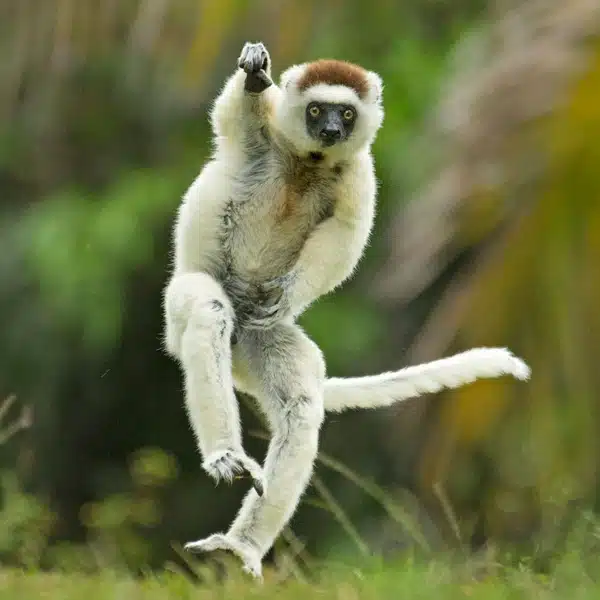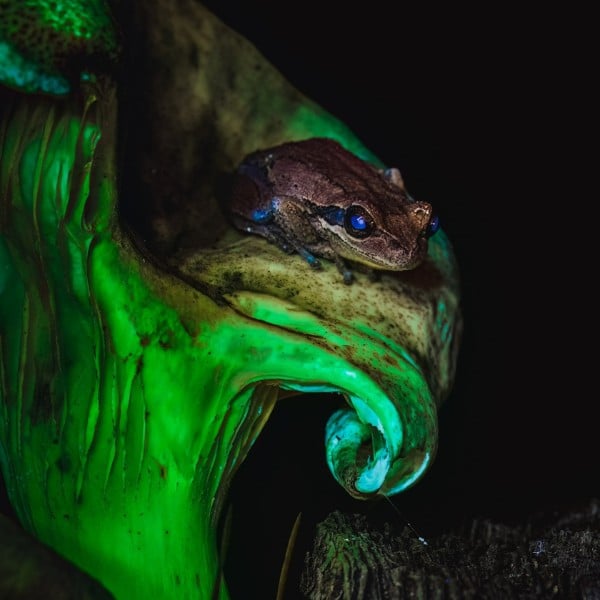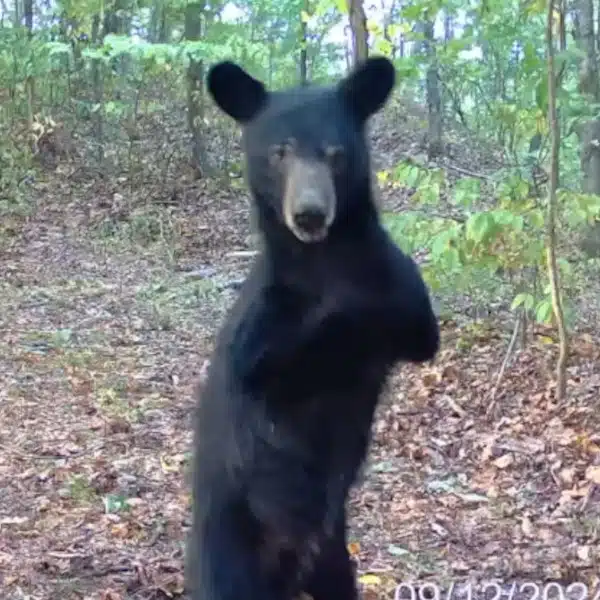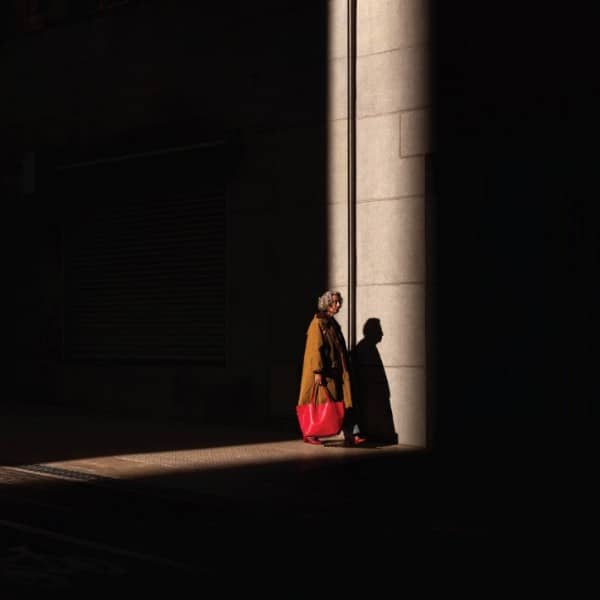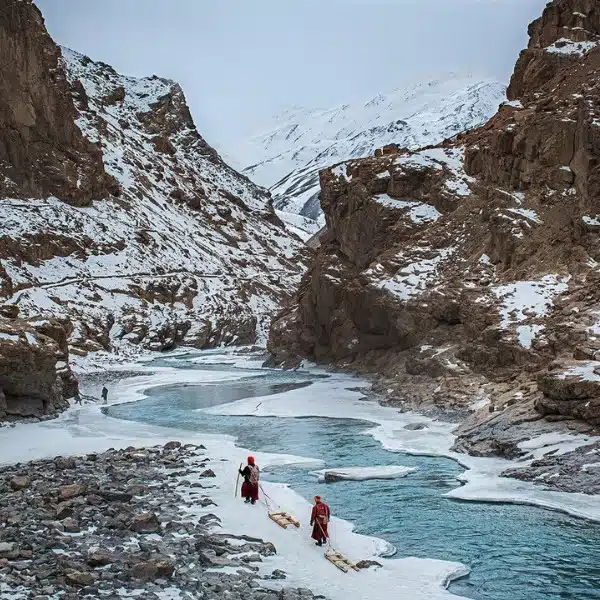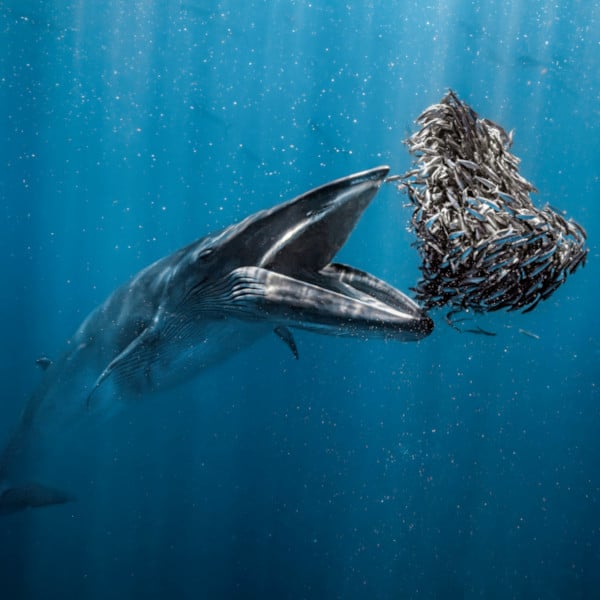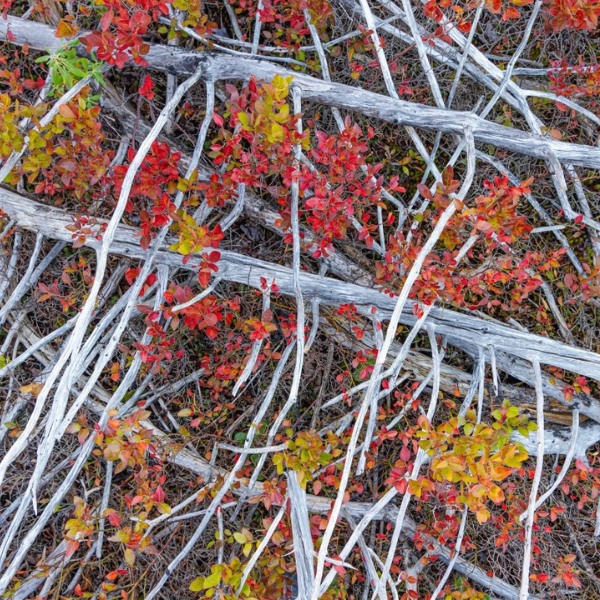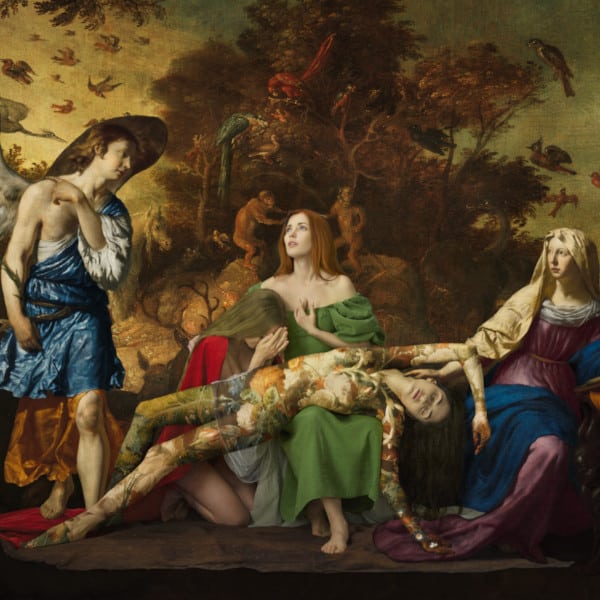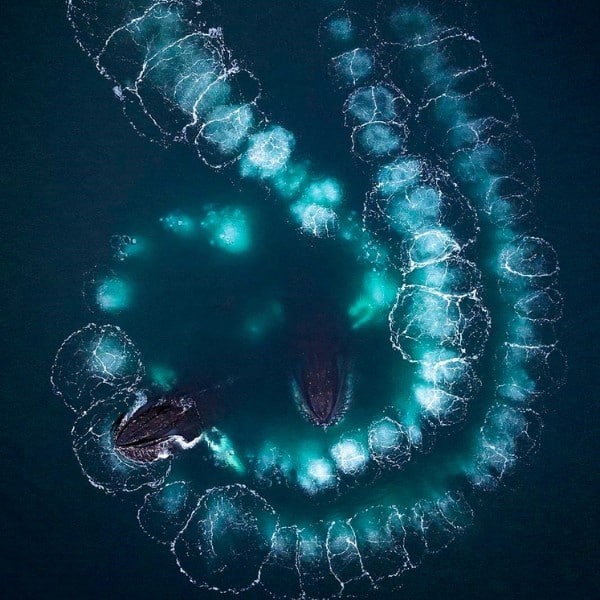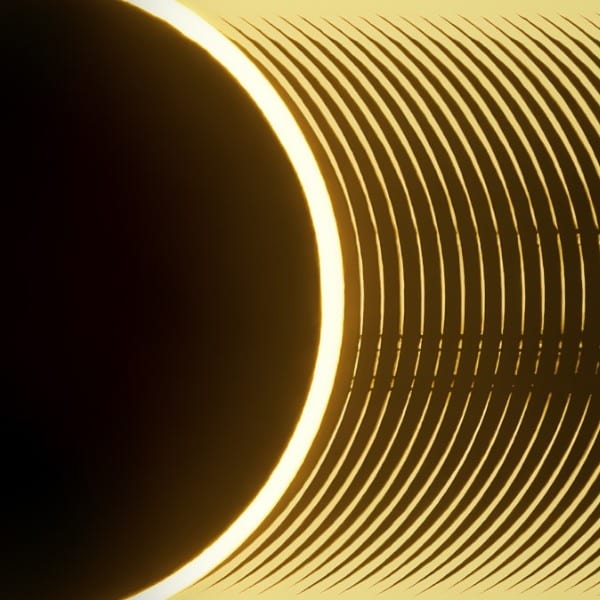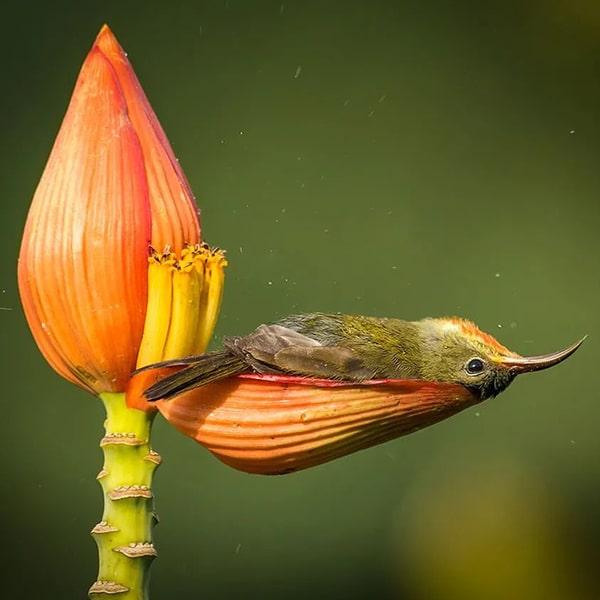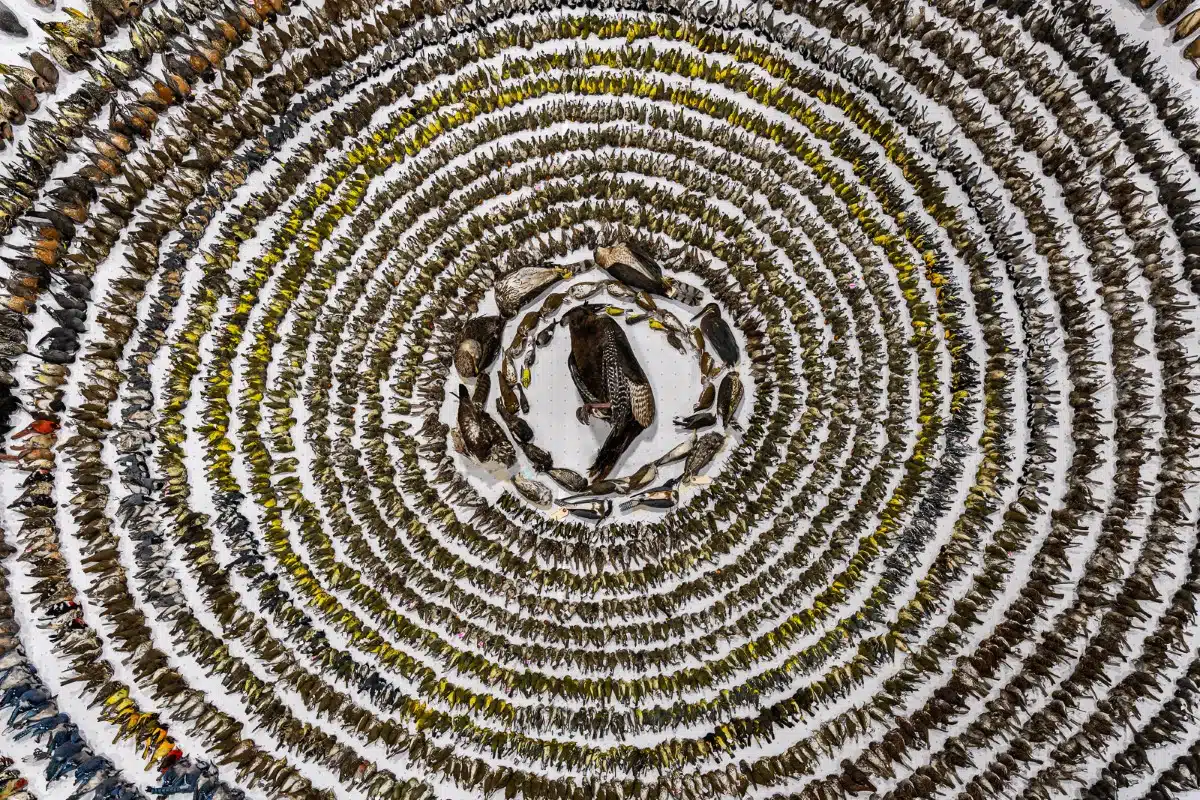
“When Worlds Collide” by Patricia Seaton Homonylo, Canada. Overall Winner and Winner, Conservation.
Species: Migratory birds, various.
“Each year during spring and fall migration over 1.3 billion birds die in North America as a result of window collisions. A network of dedicated volunteers heads out each morning to pick up the pieces. For over 30 years FLAP (Fatal Light Awareness Program) volunteers have patrolled cities worldwide in search of birds that have collided with windows. While their efforts have saved an impressive number of bird collision survivors, the majority do not survive the impact. But the fallen birds are never left behind. Their bodies are collected and their lives honored in the annual ‘Bird Layout’. The Layout brings volunteers together to arrange the dead birds in an emotive and provocative display. While The Layout honors the fallen birds and brings closure for the volunteers, it is also a critical event that raises public awareness and highlights a global issue. I have volunteered with FLAP for four years and attend The Layout annually. From hawks to hummingbirds, this 2022 display includes more than 4,000 birds.”
A startling look at the after-effects of window collisions won animal photojournalist Patricia Seaton Homonylo the 2024 Bird Photographer of the Year contest. Her poignant photograph beat out more than 23,000 images that were submitted by photographers from around the world. Showing the “Bird Layout” event featuring over 4,000 birds that perished in Toronto due to window collisions, the image raises awareness about the manmade peril that our feathered friends face.
“Each year, more than one billion birds die in North America alone due to collisions with windows,” says Homonylo. “I am a conservation photojournalist and have been working with the Fatal Light Awareness Program, where we save window-collision survivors in Toronto. Sadly, most of the birds we find are already dead. They are collected, and at the end of the year, we create this impactful display to honor the lives lost and increase public awareness.”
“I hope people are shocked by what they see and are moved to act by using bird-safe glass and supporting organizations like FLAP.”
Homonylo not only won the overall competition, but also topped the Conservation category for her efforts. To support bird conservation efforts, the competition made a donation to Birds on the Brink, which provides funding to grassroots bird conservation projects around the world.
“The mark of a good photograph is one that either demonstrates artistry or tells a story. The mark of an exceptional one is that it does both,” says Paul Sterry, Birds on the Brink trustee. “This is just such a photograph, portraying a tragic and often overlooked aspect of man’s impact on the environment and an unintended consequence of our species’ high rise aspirations, which turns out to be yet another devastating threat to wild birds.”
Awards were also handed out in eight different categories in the adult competition, as well as three youth categories. The Young Bird Photographer of the Year 2024 was awarded to 14-year-old Spanish photographer Andrés Luis Domínguez Blanco for his creative angle on a nuthatch scrambling down an oak tree.
Scroll down to view the winners, who will see their work featured in a coffee-table book published by Princeton University Press.
Here are the incredible winners of the 2024 Bird Photographer of the Year contest.
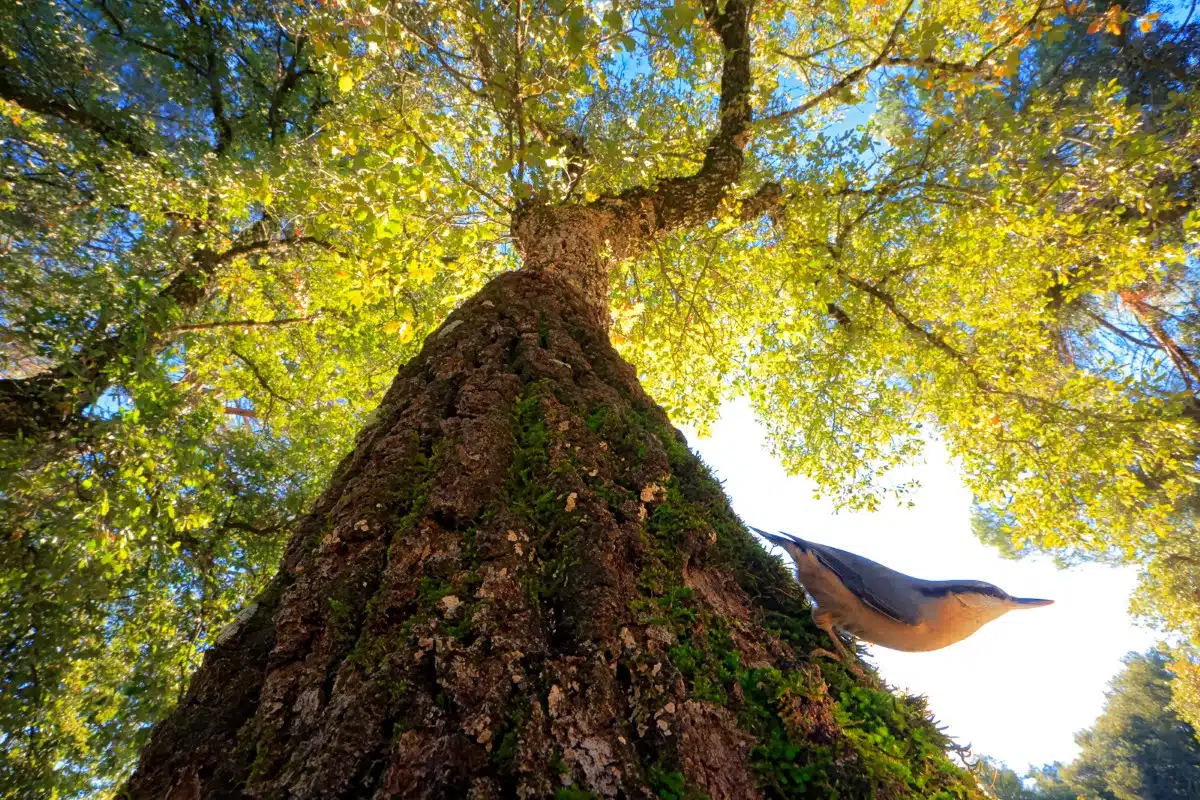
“Perspective” by Andrés Luis Domínguez Blanco, Spain. Winner, 12-14 Years.
Species: Eurasian Nuthatch, Sitta europaea.
“I photographed this Eurasian Nuthatch at Grazalema in southern Spain using a wide-angle lens. An oak tree next to a river provides cover for species such as woodpeckers and nuthatches coming down to drink. I was using a remote-control set-up, and I just had to wait. Since these species like to climb trunks, I thought about what their vision and perspective would be like.”
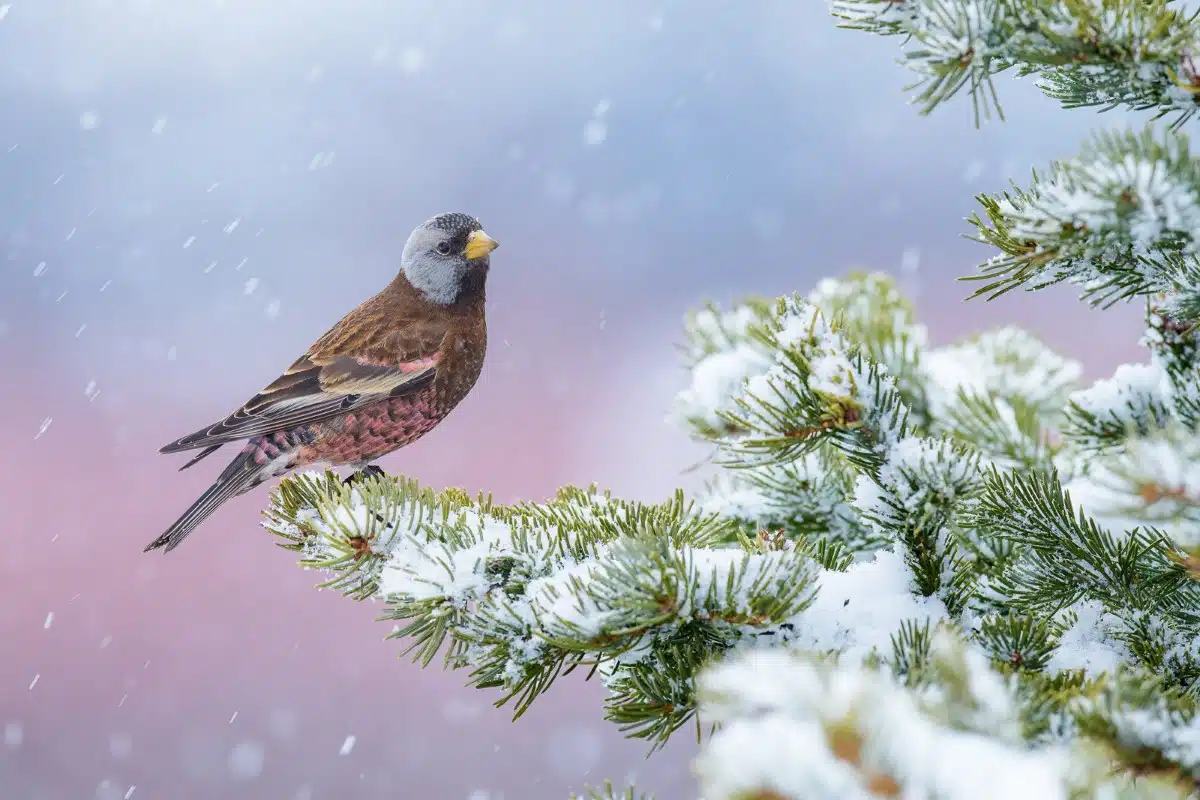
“Winter Pink” by Alan Murphy, United States. Winner, Portrait.
Species: Grey-crowned Rosy-finch, Leucosticte tephrocotis.
“During my stay in Alaska, Grey-crowned Rosy-finches would gather in large flocks next to my hotel. Fortunately for photographers, they are a very tame species and they allowed me to set up my tripod and camera to grab a few frames before they all took off. The colors in the background are distant boats in a marina.”
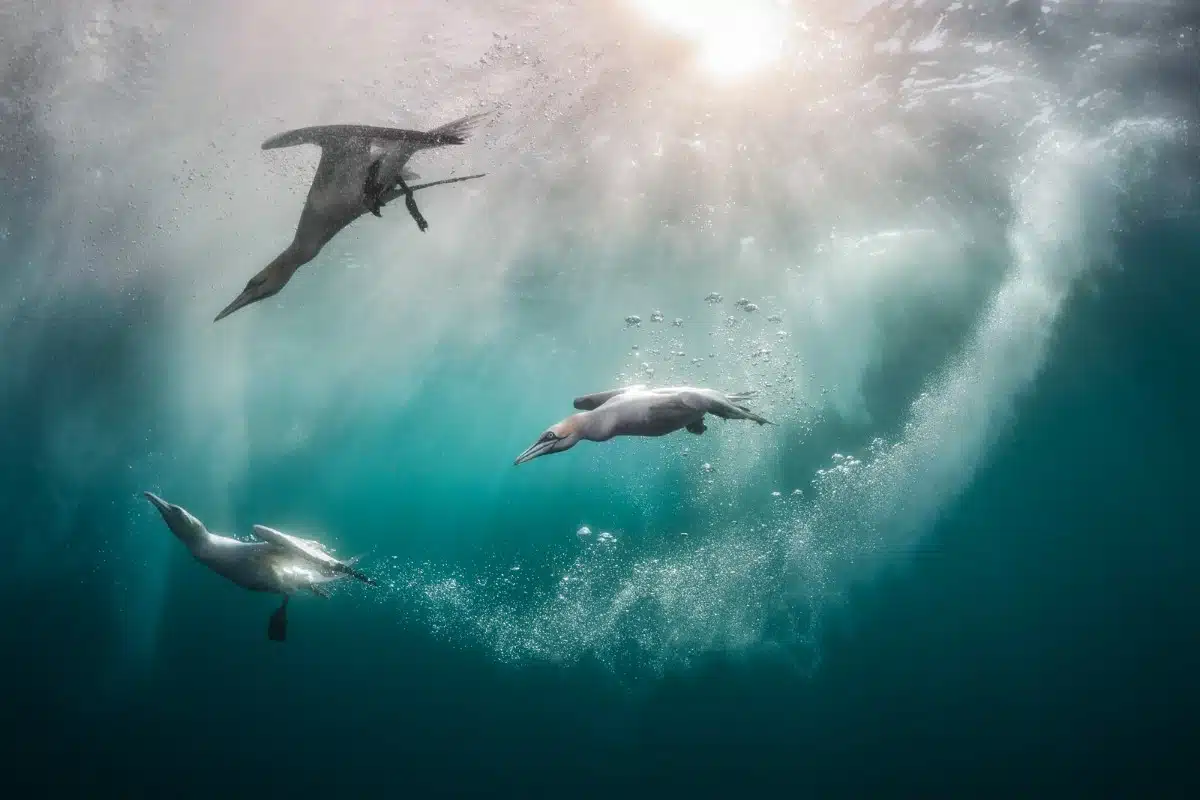
“Immersion” by Kat Zhou, United States. Winner, Birds in the Environment.
Species: Northern Gannet, Morus bassanus.
“Here we see a trio of Northern Gannets diving into the ocean on a sunny day in Shetland. The species is Scotland’s largest seabird, and they are remarkably adept in the water, with the ability to dive to depths as far as 22 meters. I took this photo while scuba diving from a boat near Noss, which is home to the UK’s seventh largest colony of Northern Gannets. In the past the population has been estimated at around 25,000 birds, though their numbers were unfortunately severely reduced by the avian flu outbreak. It is unclear when, or if, their population will be able to recover. Dead herring from a local herring fishery were used to attract the birds to the boat.”
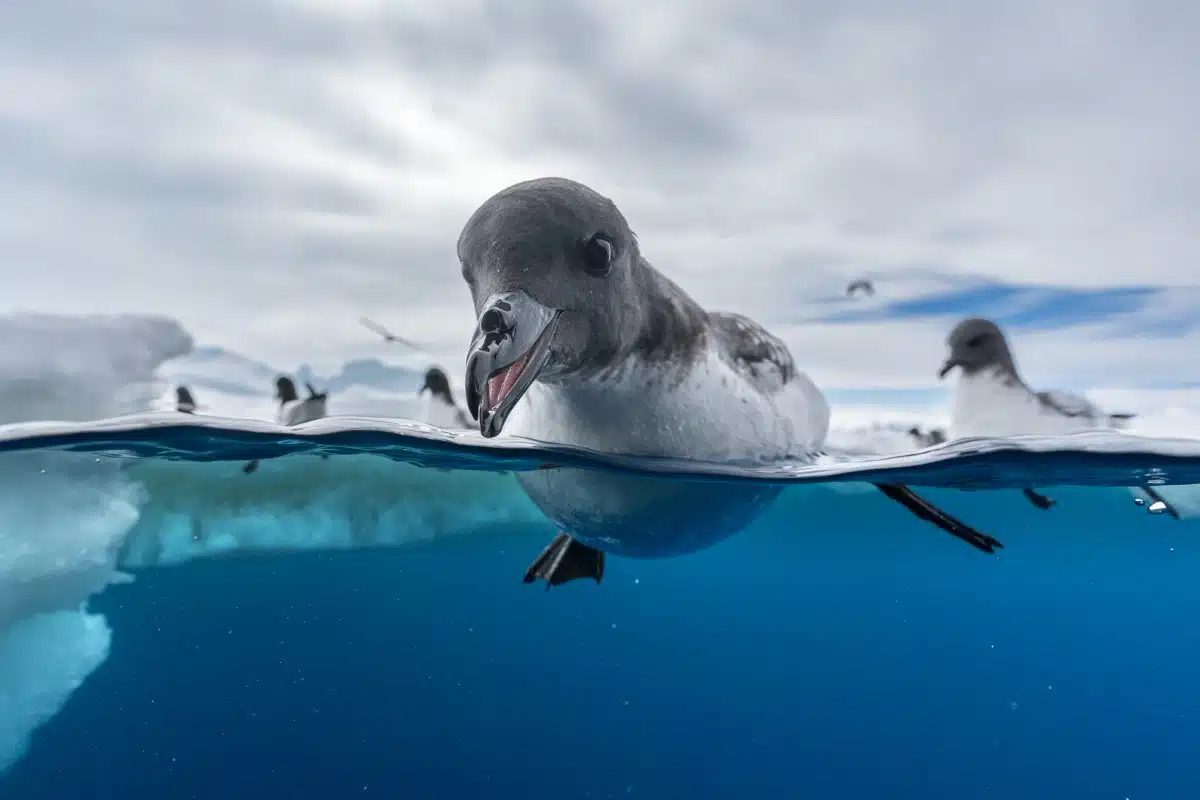
“Feeding Frenzy” by Jonas Beyer, Denmark. Third Place, Birds in the Environment.
Species: Cape Petrel, Daption capense.
“I was cruising in a Zodiac when I saw a group of Cape Petrels in the water. As I approached I could see they were feeding on something, along with Giant Petrels and Snow Petrels. I had my big underwater rig with me and thought it was a chance for a split sea surface photo. As I slowly drifted closer, I noticed all the birds were too busy feeding to care about me being around. So I ‘parked’ the boat next to some ice, leaned over the side and dropped my underwater housing in the water, then waited for the birds to come close. I really wanted to capture a photo showing both above and below the surface. Even though we cannot see exactly what they are feeding on, I love this perspective of both worlds in one shot.”
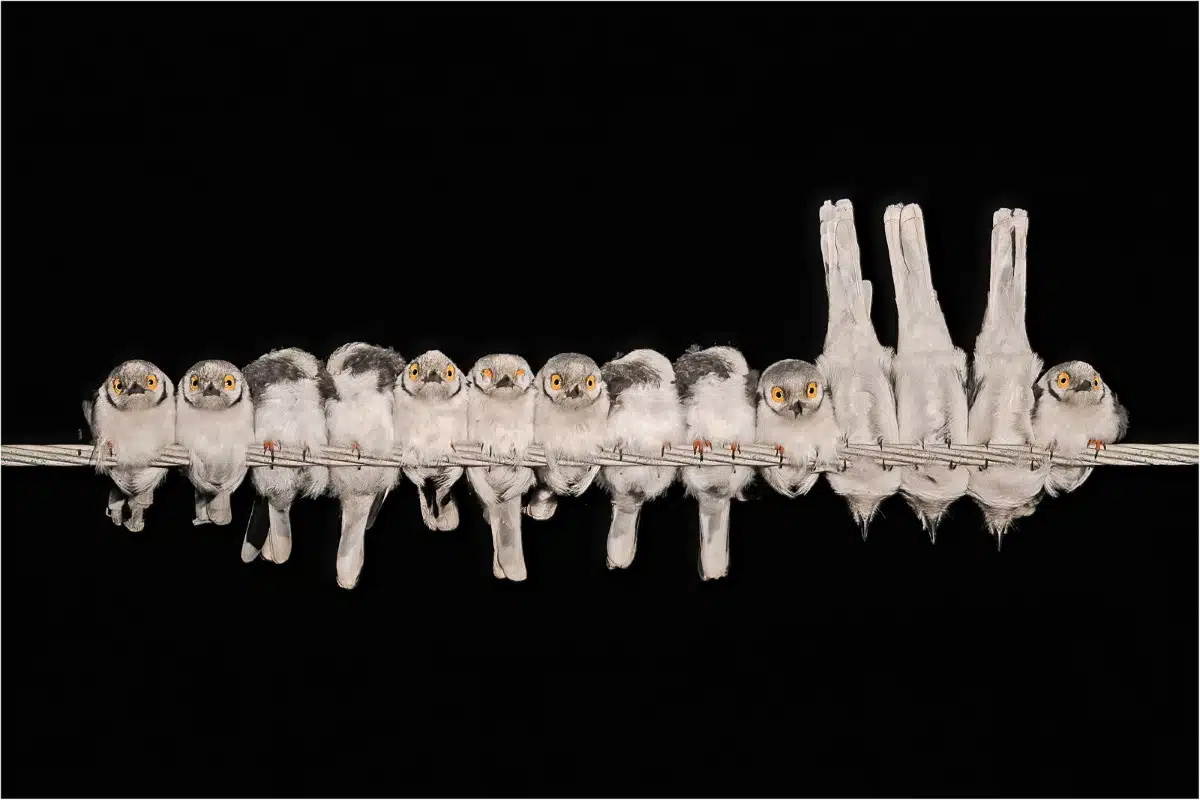
“Helmetshrikes Preparing to Sleep” by Gary Collyer, United Kingdom. Third Place, Comedy Bird Photo.
Species: White-crested Helmetshrike, Prionops plumatus.
“We were on a safari, and returning to camp in Sabi Sands, South Africa, on a dark March evening. We stopped, having picked up some unusual sounds, although unsure what they were. Then we heard chattering and fluttering high above us. When illuminated with the lamp on the vehicle, we saw these helmetshrikes huddling together against a night that was starting to turn colder. Another wonderful experience in Africa!”
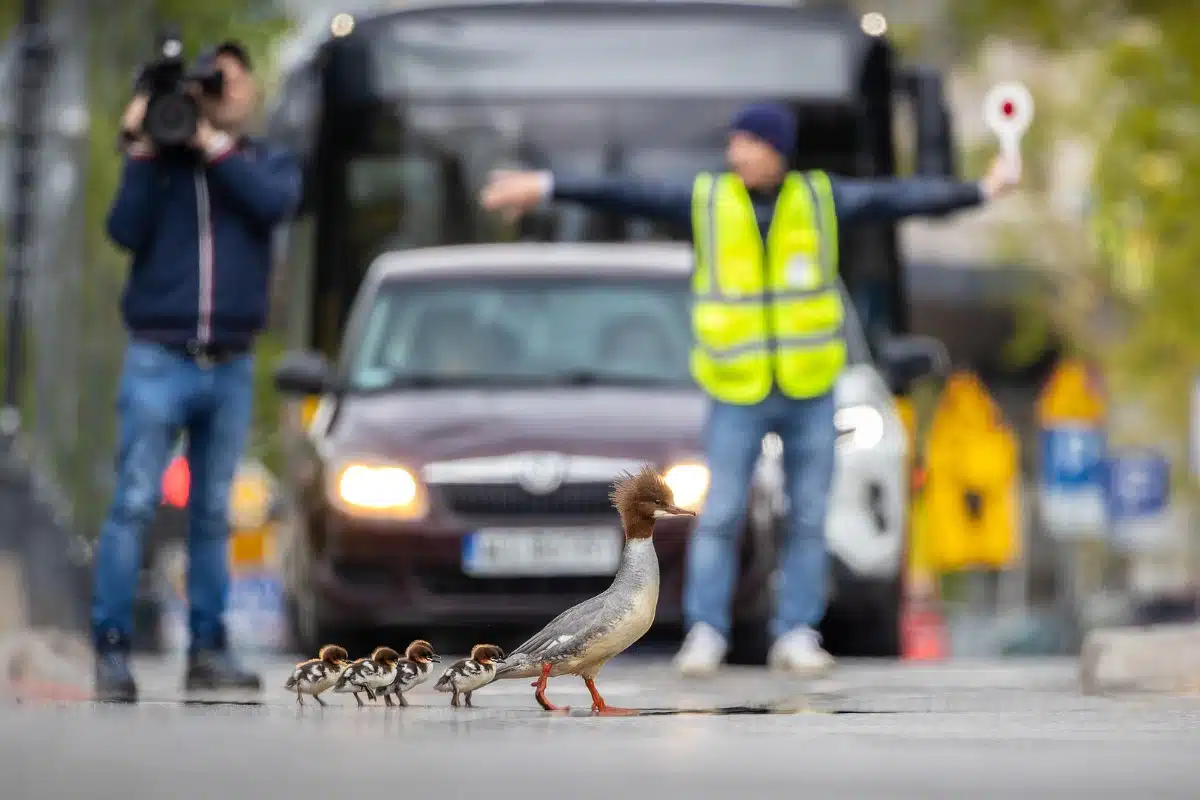
“Treacherous Journey” by Grzegorz Długosz, Poland. Winner, Urban Birds.
Species: Goosander, Mergus merganser.
“Goosanders breed in the park about 1 kilometer from Poland’s life-giving River Vistula. Each mother has to move her brood to the river as quickly as possible due to lack of food and safety in the park. They make the journey through a series of underground passages and over a six-lane highway. Each year a group of volunteers help them cross this deadly road by stopping the traffic. After crossing they arrive at the River Vistula where they can feed and grow. This image shows a mother Goosander crossing a smaller road because she decided not to use the scary and dark underground passage below it.”
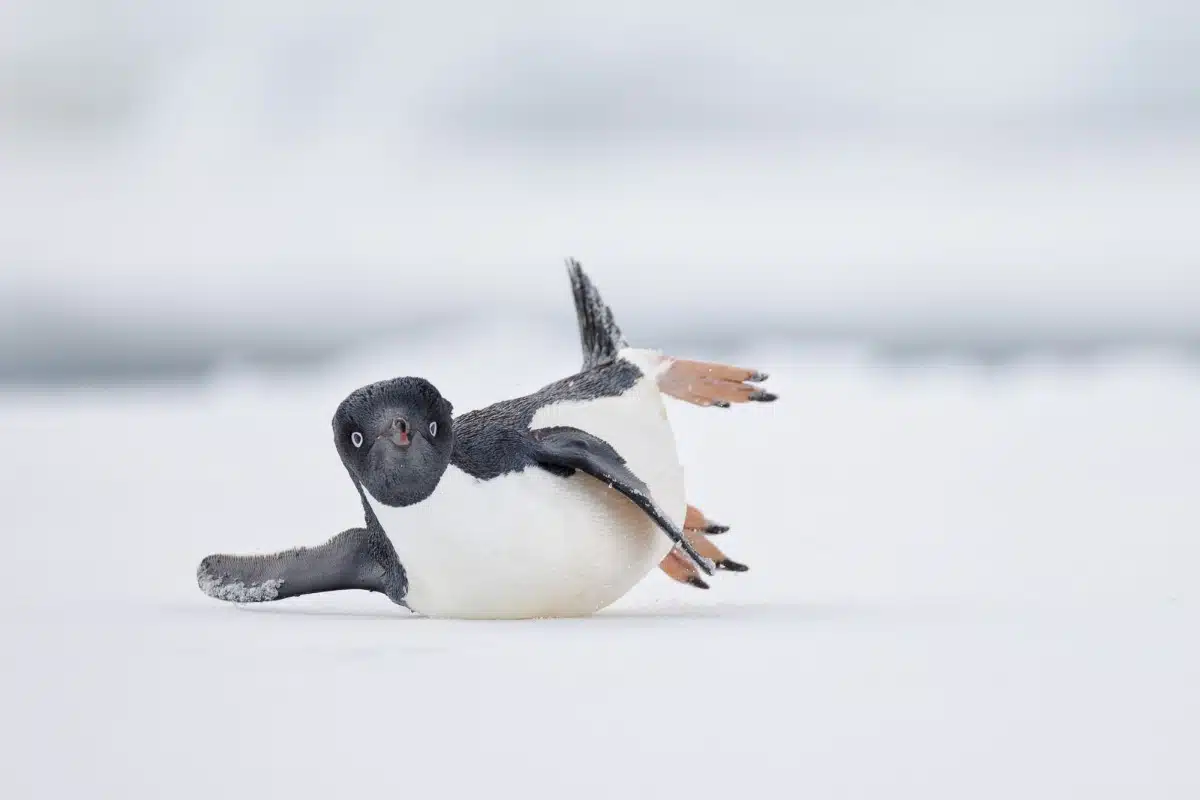
“A Modern Dancer” by Nadia Haq, United States. Winner, Comedy Bird Photo.
Species: Adélie Penguin, Pygoscelis adeliae.
“I was sitting on a Zodiac next to my husband and 10-year-old son near Brown Bluff, Antarctica, when we spotted a group of Adélie Penguins on some sea ice. As we slowly approached them, they started to toboggan on the ice, and I captured one of them sliding as if performing a modern dance move.”
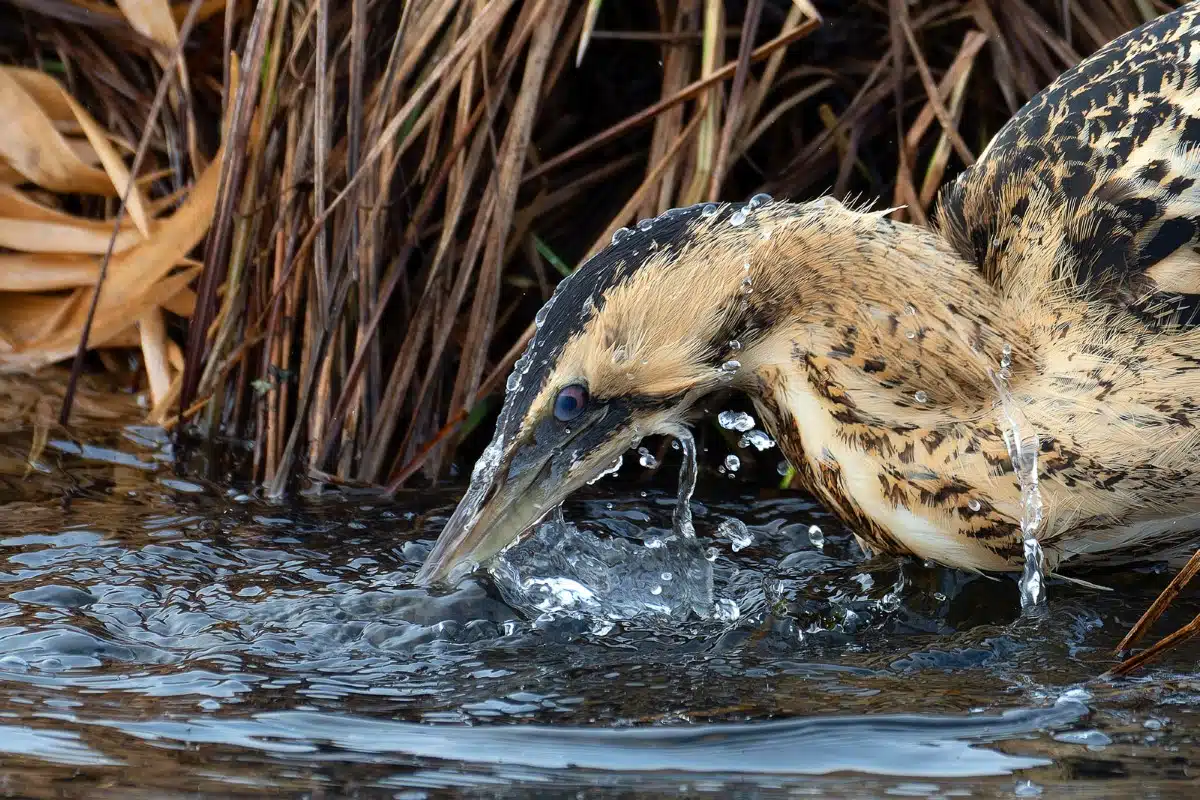
“Turbulent Fish Hunt” by Julian Mendla, Germany. Winner, 11 and Under.
Species: Eurasian Bittern, Botaurus stellaris.
“Lake Federsee is a famous wintering area for numerous migratory birds. From November to March, Eurasian Bitterns are frequent visitors to this lake. As soon as the lake freezes over, these rare birds retreat to trenches through the reeds. Surprisingly, this individual was very close to the boardwalk that leads through the nature reserve. From there, I could easily watch its fishing campaign and take numerous photos.”
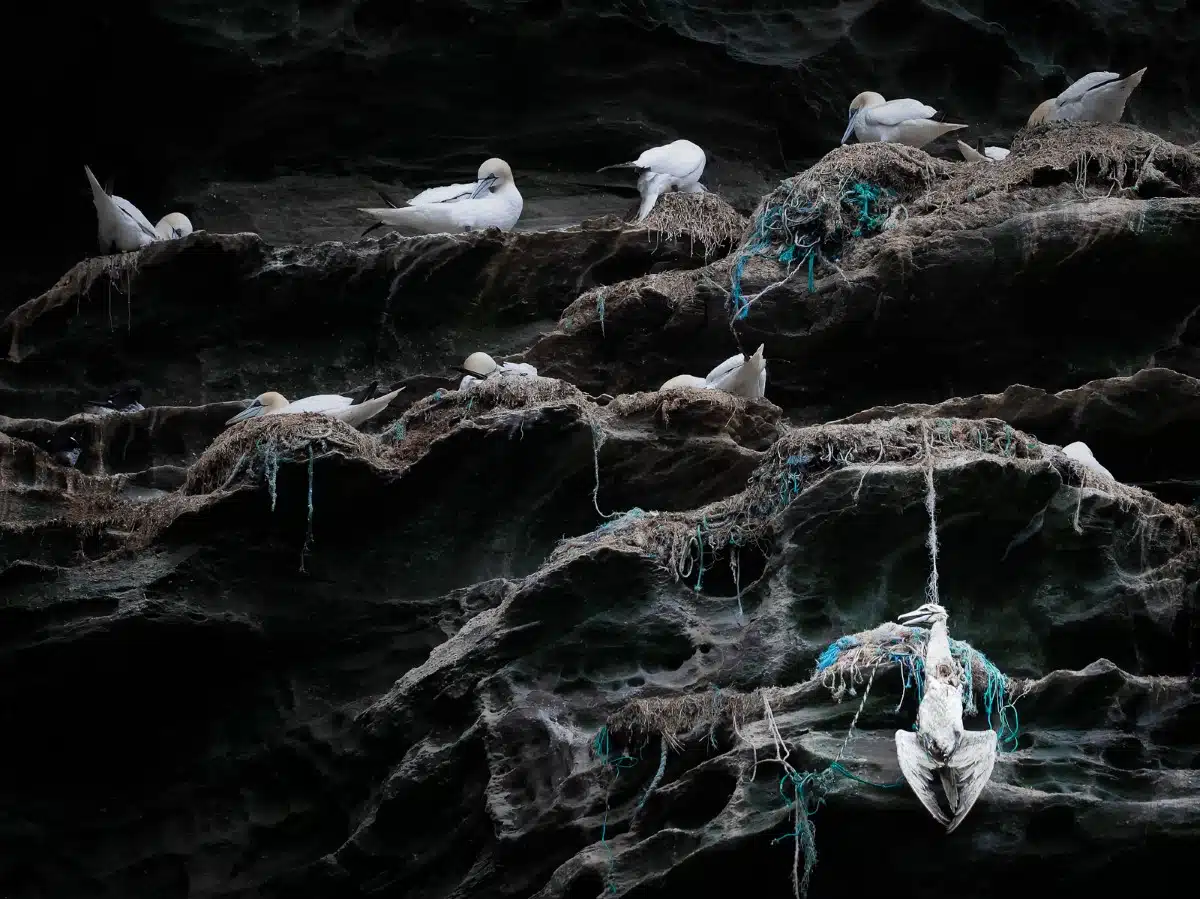
“Postmortem” by Joshua Galicki, United States. Third Place, Conservation.
Species: Northern Gannet, Morus bassanus.
“A deceased Northern Gannet hangs from a fishing line as its former peers surround it and go about their daily lives on the Isle of Noss. Gannets are known to use a variety of artificial nest material, and this is yet another threat to their numbers as they try to raise their offspring successfully. It is important to note that this same colony of birds was decimated the previous year due to avian flu. I took this image as a reminder of an additional obstacle we put in the way of this species, which is compounded with other challenges, including disease and climate change.”
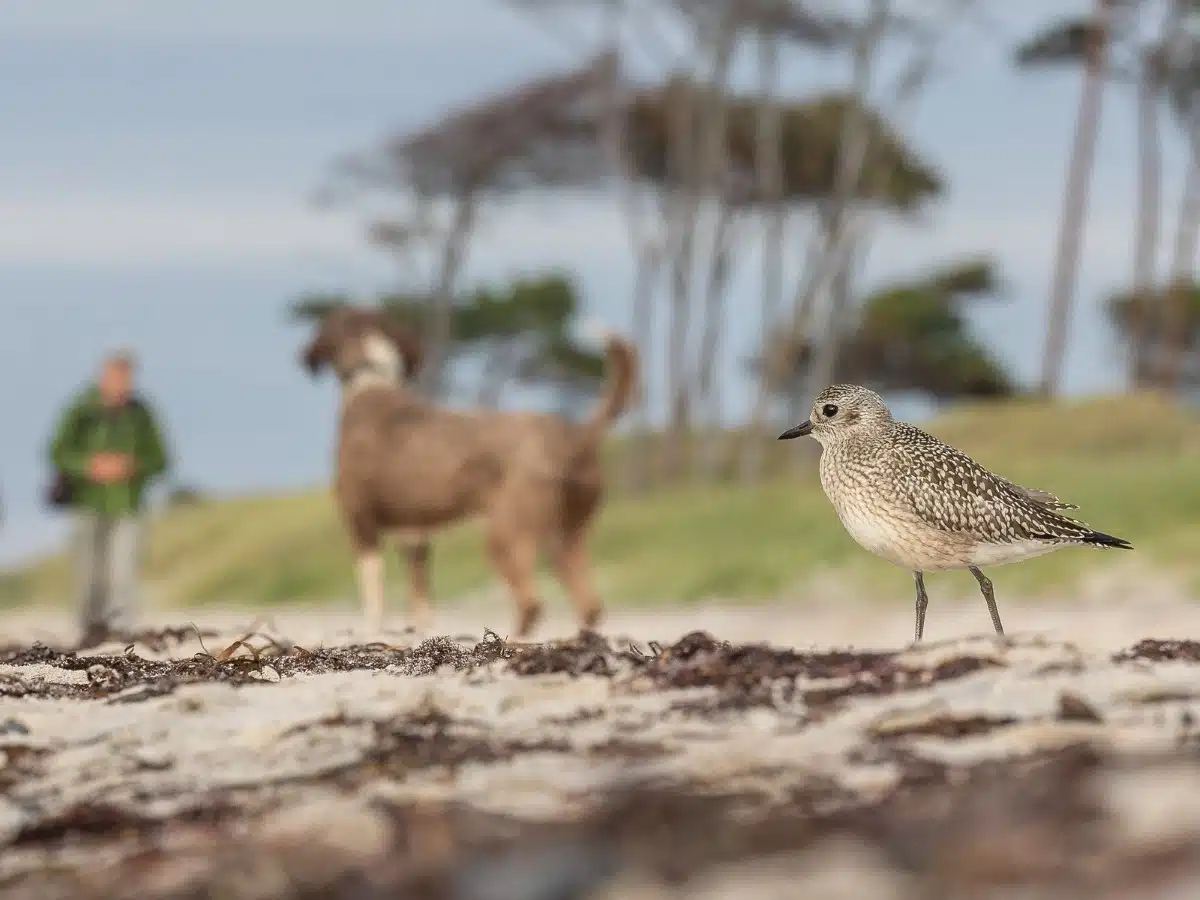
“Human and Nature (And Dog)” by Emil Wagner, Germany. Winner, 15-17 Years.
Species: Grey Plover, Pluvialis squatarola.
“I took this photo on a beautiful beach on the Baltic Sea. There are a number of waders and other birds here, but also many visitors who enjoy the beautiful landscape. In this case there was also a dog who initially did not notice the Grey Plover. The Grey Plover, however, did notice the dog and flew away shortly after I took the photo. While I do not believe this incident greatly stressed the bird, it is crucial to acknowledge the potential impact of human activity and tourism on protected species and their habitats. In my opinion, the scene represents this potential conflict between humans and nature.”
Over 23,000 images were submitted to this year's competition.

“Scavenger” by Nathaniel Peck, United States. Winner, Bird Behaviour.
Species: Turkey Vulture, Cathartes aura
“In early March 2023, the remains of an American Black Bear were discovered by hikers along a rushing mountain stream in West Virginia. It was very clear from the large patches of missing fur that the bear had died after a battle with mange. After being informed of the carcass and securing permission, I set up a DSLR camera trap that took images of all the animals that came in to investigate and scavenge off the bear. The set-up remained in place for six months. As the weather warmed in spring, this Turkey Vulture became a frequent visitor, sometimes spending hours at the carcass.”
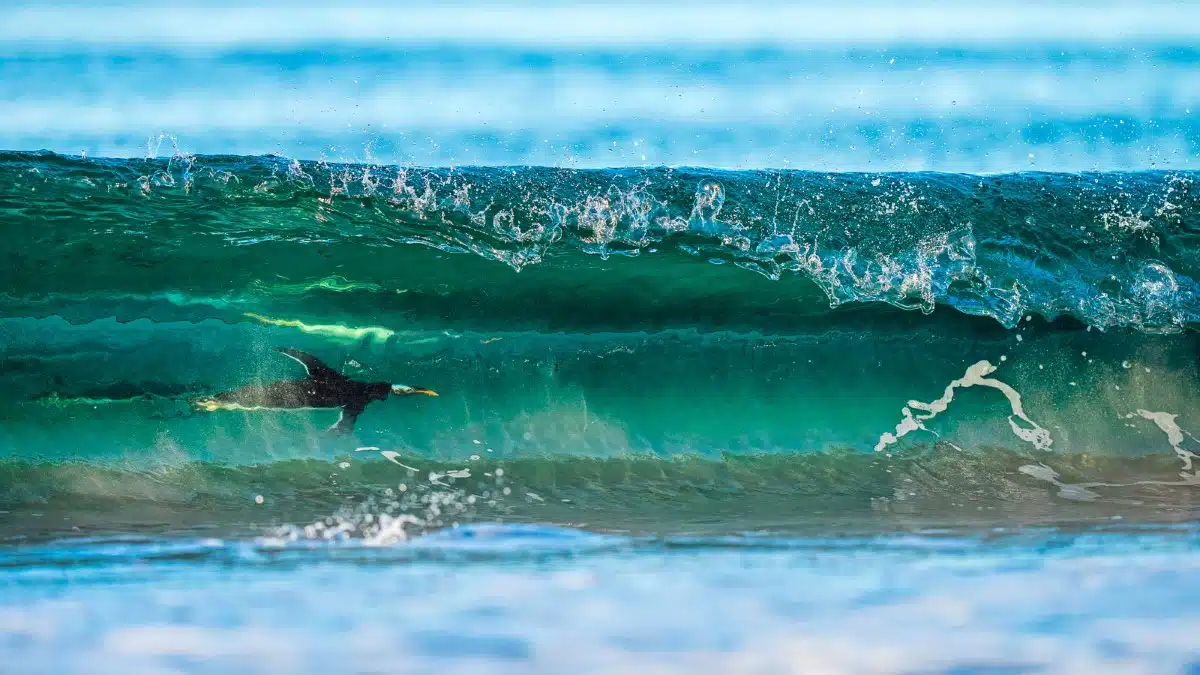
“Surfing on the Other Side” by Levi Fitze, Switzerland. Runner-Up, Birds in the Environment.
Species: Gentoo Penguin, Pygoscelis papua.
“In autumn 2022 I had the chance to visit the Falkland Islands. During my last days on the islands, I found an area along a beach where Gentoo Penguins surf in the waves when coming back from their hunting dives. After many attempts I got exactly the image I was hoping for. Not too long ago, people used to wipe out whole colonies of Gentoo Penguins and others of their kind. Their eggs were a food source, but the birds themselves were prized because of their layer of fat, which was used to render oil for lighting.”
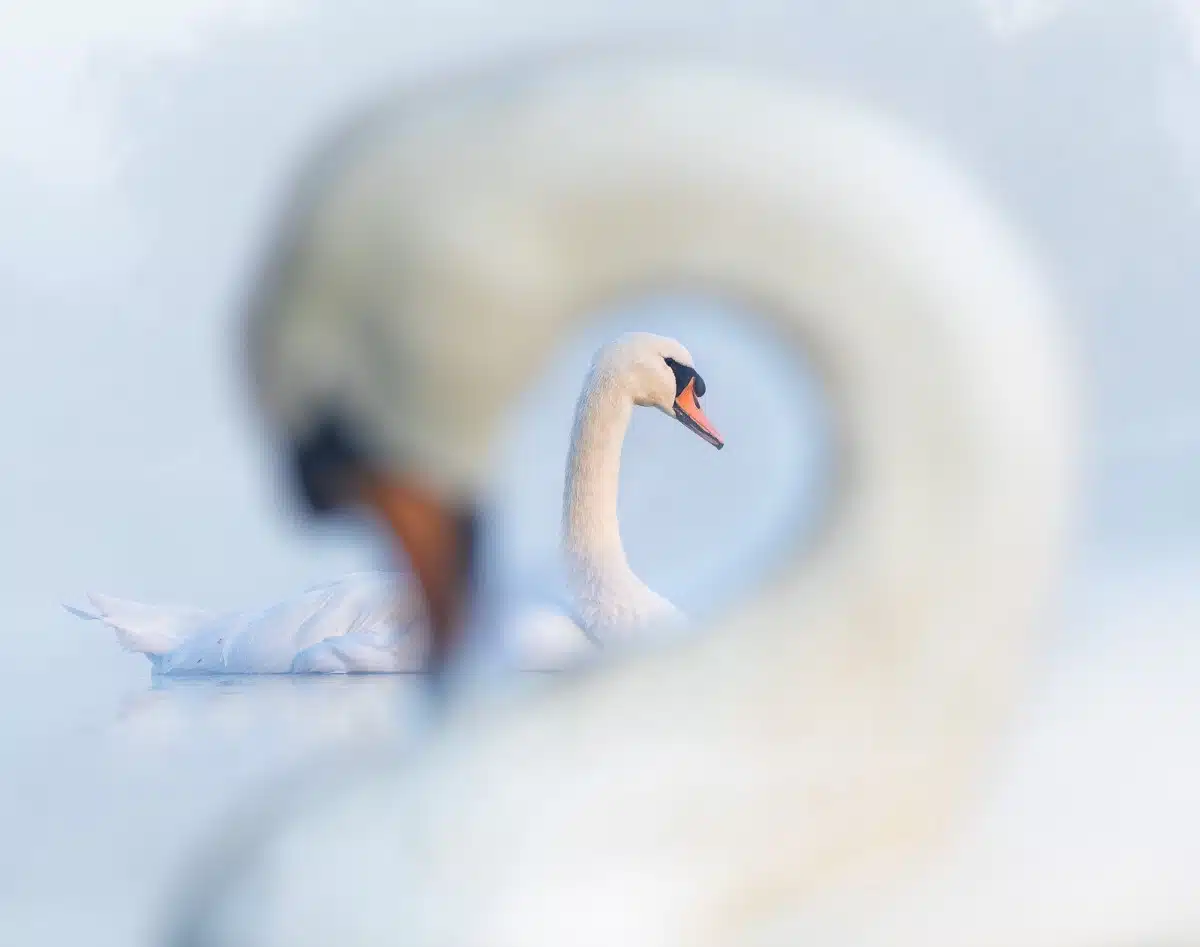
“Swanception” by Samual Stone, United Kingdom. Runner-Up, Portrait.
Species: Mute Swan, Cygnus olor.
“I conceived the idea for this image some time ago, but each time I attempted to turn it into reality one of the elements was not right. It felt like I was in a creative rut and I had not taken an image I was really happy with for a while. On this particular morning, I decided to return to this idea out of desperation. I spotted my local Mute Swans in their usual spot, preening in the morning light. Fortunately, it was also a crisp morning, and the mist was slowly descending, creating a soft morning glow. After so many attempts, everything finally came together when a swan swam into the perfect spot. Finally, I created the image I had pictured in my mind.”
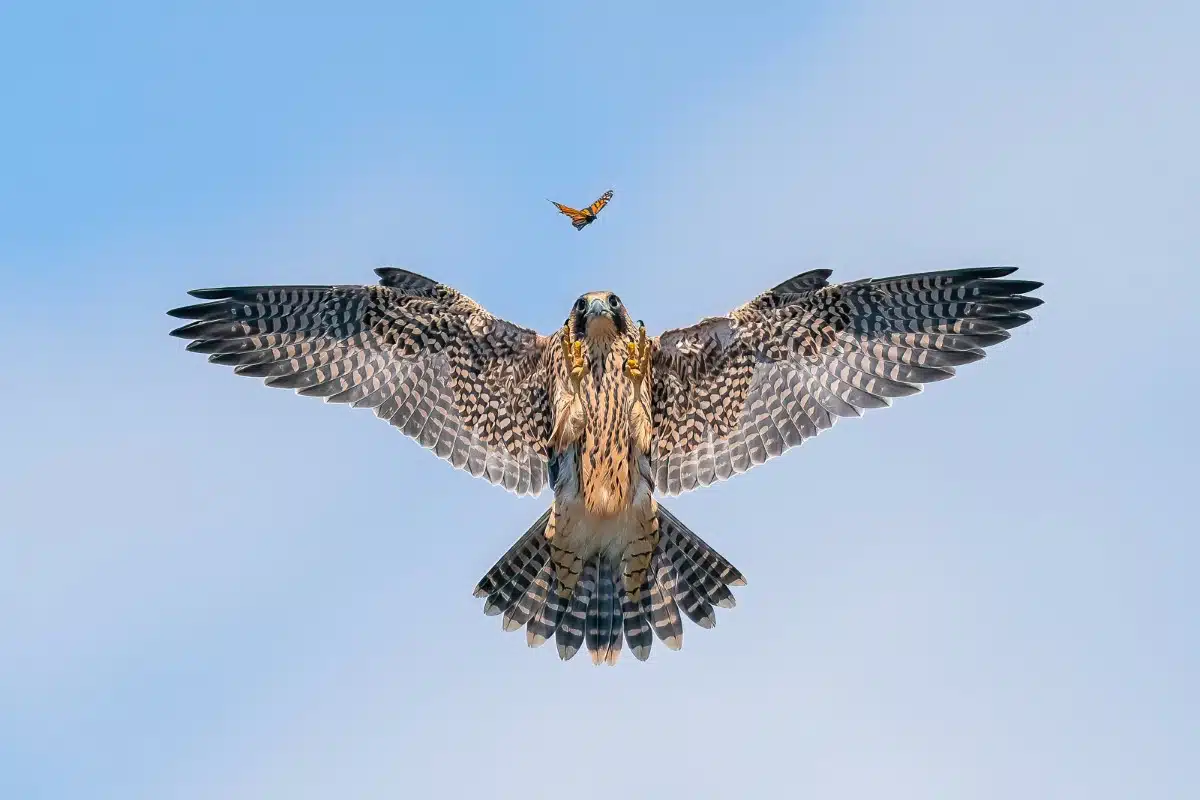
“Playful Fledgling” by Jack Zhi, United States. Runner-Up, Bird Behaviour.
Species: Peregrine Falcon, Falco peregrinus.
“This Peregrine Falcon fledgling had been flying for over a week and his skills had improved by the day. While he still took food from parents, he had started to practice his hunting skills. He was not good enough to catch live birds in the air yet, so he took baby steps by chasing a fluttering butterfly. He was certainly much faster than the butterfly and also nimble enough to keep up with it. Look at the concentration! He was successful on occasion, caught the butterfly, played with it for a second, then released it. I have been photographing peregrines for years, and this was the first time I have seen fledglings play with butterflies.”
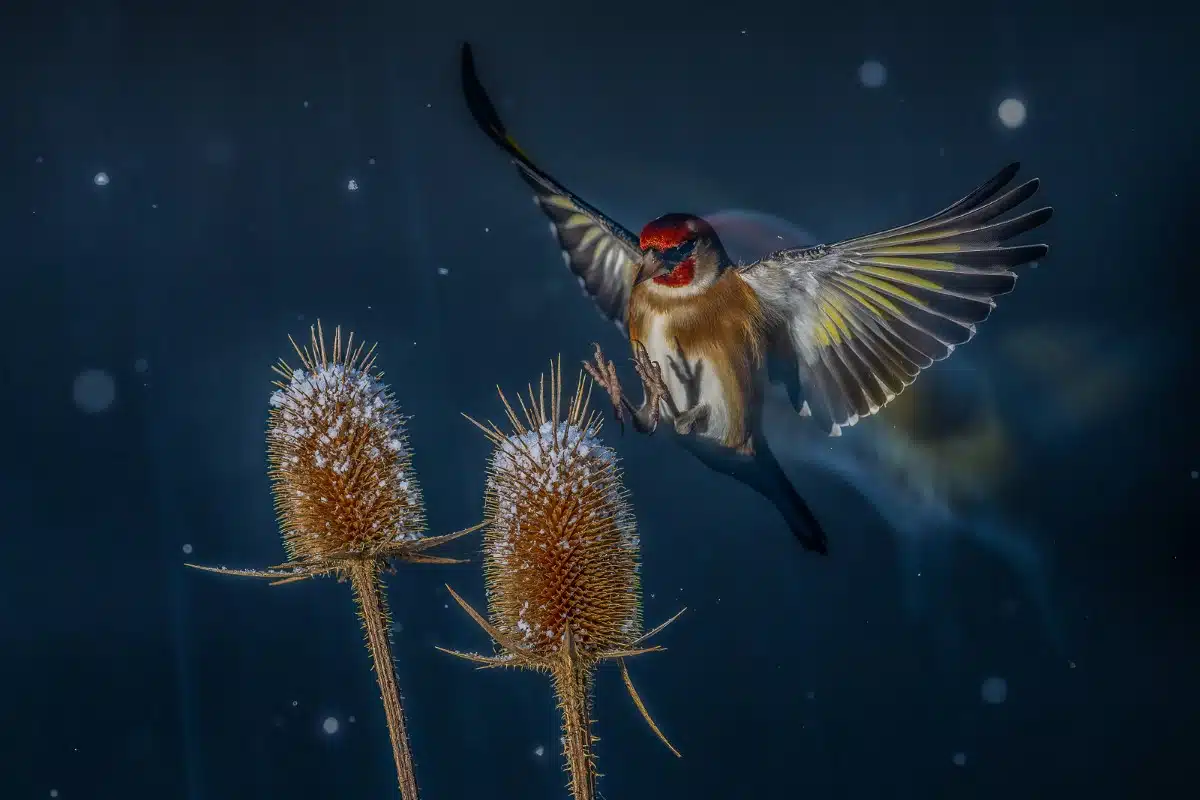
“Heavenly Elegant Flight” by Nicolas Groffal, France. Runner-Up, Birds in Flight.
Species: European Goldfinch, Carduelis carduelis.
“In the dead of winter, I marvel at the aerial ballet of the garden birds that come to visit my trees and to take advantage of the seeds that I put out for them. Discreetly hidden, I tried to immortalize their flight and its delicate trail using a flash and camera in ‘rear curtain’ mode. The mission was challenging and these mischievous little models followed their own dance. However, it is precisely this spontaneity that makes the photographic challenge exhilarating! Hundreds of shots were required before I captured the perfect moment, which portrayed the fleeting magic of nature in winter.”
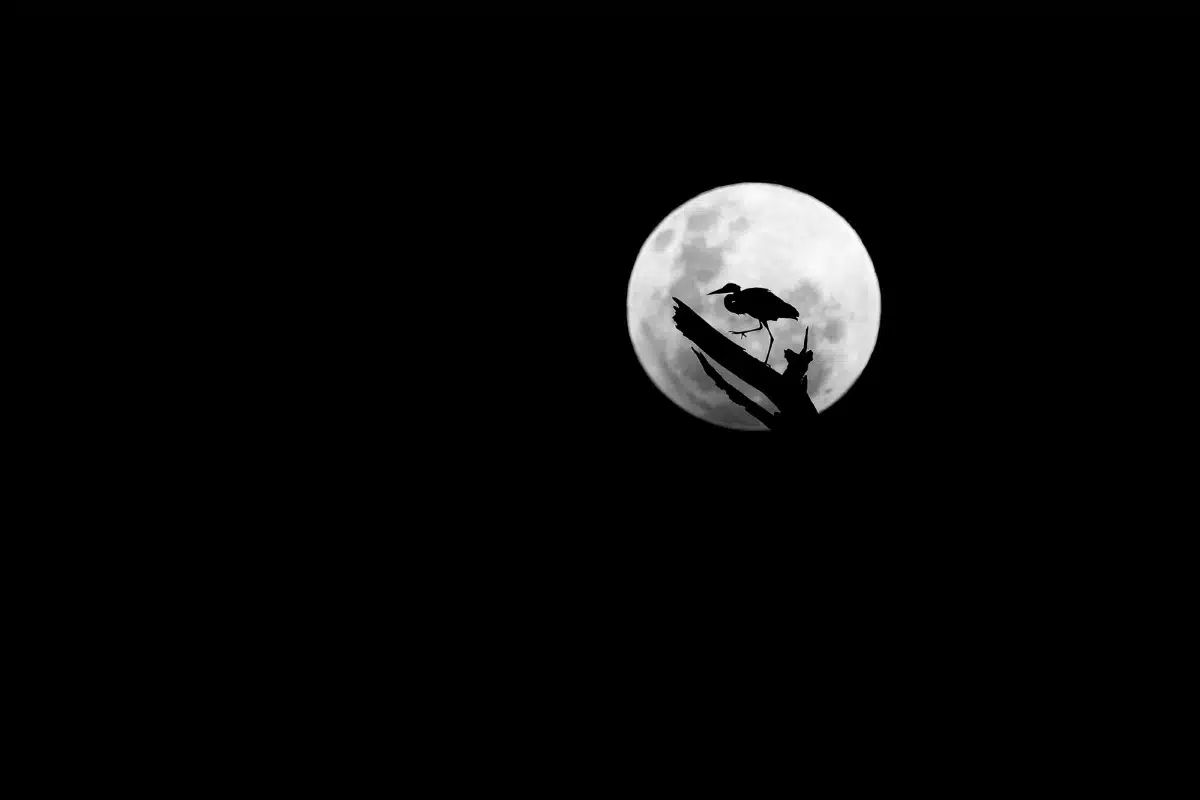
“Eclipse” by William Steel, South Africa. Runner-Up, Black and White.
Species: Grey Heron, Ardea cinerea.
“Here we see a Grey Heron as it looks for a roosting place in the top of a dead tree, illuminated by a full moon. Knowing that it was a penumbral lunar eclipse, my guests and I went in search of a distinctive subject to place in front of it. As the heron jostled for position alongside some larger Marabou Storks, we managed to capture the moment just before the heron flew away. Using a high f-stop, heavily underexposing, and keeping a slow shutter speed of only 1/200th of a second, I was able to capture some of the moon’s detail, while suppressing most of the noise.”
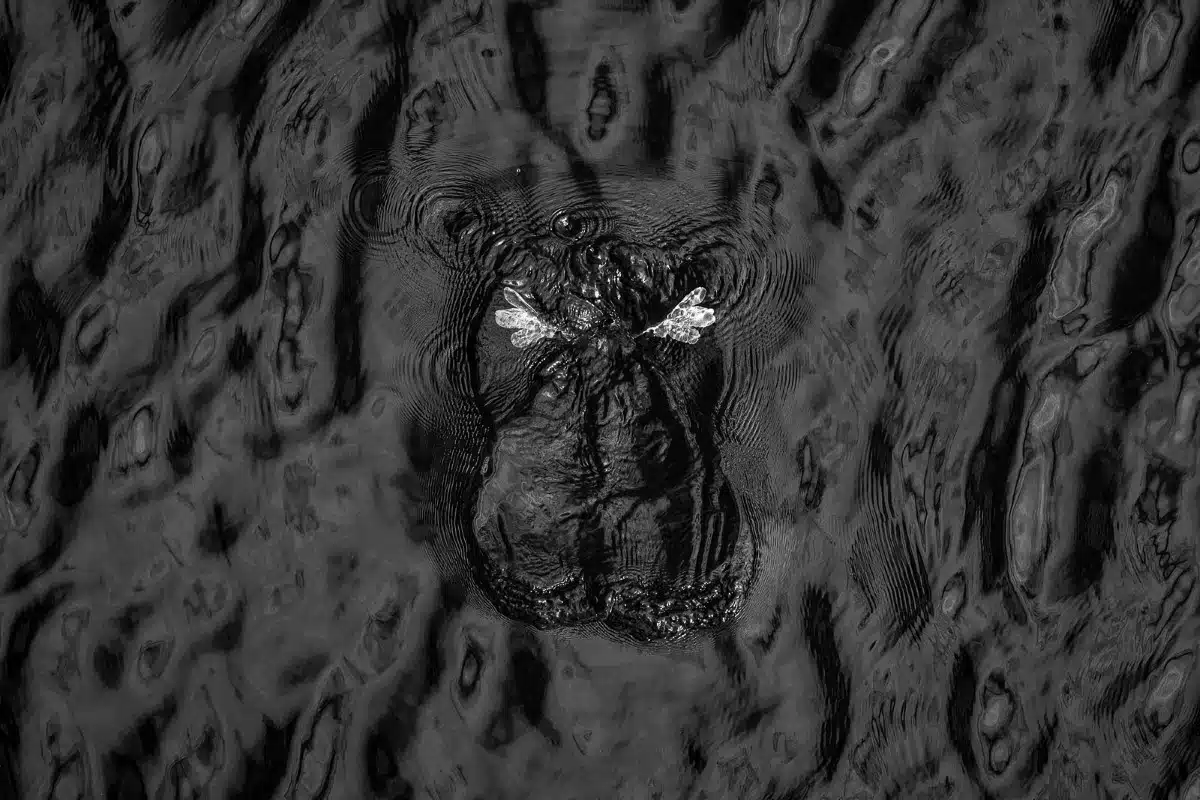
“Hippo Impression” by David Stowe, Australia. Winner, Black and White.
Species: Hoary-headed Grebe, Poliocephalus poliocephalus.
“This photograph shows a Hoary-headed Grebe as it disappears below the surface of the water to feed, pushing into the depths with its huge paddle-like feet. I took the image from a raised platform high above the wetland. With a little bit of imagination, the combination of bird and ripples look like the head of a hippo.”
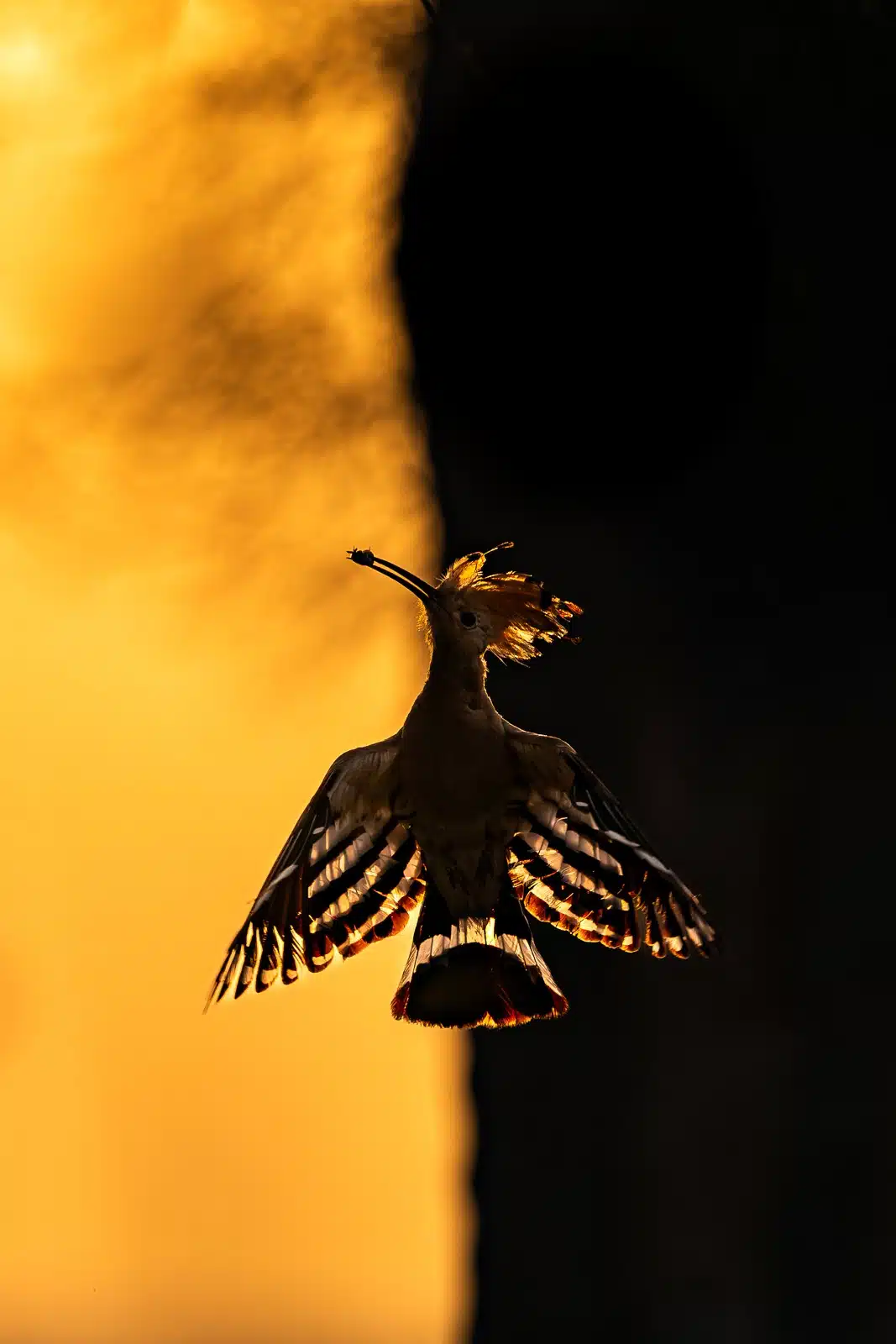
“Dawn's Whispers: Graceful Hoopoe Silhouette at Sunrise” by Hermis Haridas, India. Winner, Birds in Flight.
Species: Eurasian Hoopoe, Upupa epops.
“A Eurasian Hoopoe took flight with its wings spread in a smooth motion across the canvas of the early-morning sky illuminated by the sunrise’s bright hues. I saw that this bird would occasionally grab its prey in the air and other times on the ground. Additionally, I noticed that each time it caught prey, it flew in the same direction to a nearby tree. That was when I had the idea to photograph the bird against a background divided into dark and light, representing the contrasting sides of existence. The following morning, I returned to the same spot well before sunrise, eager to witness nature’s spectacle unfold once again. Anticipation heightened as the first rays of light bathed the landscape, and, true to my expectations, the hoopoe appeared in the distance, gliding gracefully towards the perch that was familiar from the previous day. With my camera poised and settings adjusted, I commenced capturing the unfolding scene. Among the flurry of clicks, I chanced upon a frame that resonated deeply with me – a moment frozen in time, brimming with unique charm. It was as if nature had bestowed upon me a gift, a singular composition that encapsulates the essence of the hoopoe’s beauty and grace. Indeed, many have remarked that this frame is a marvel that cannot be replicated – a testament to the serendipitous wonders that await those who seek them amid the natural world.”











































































